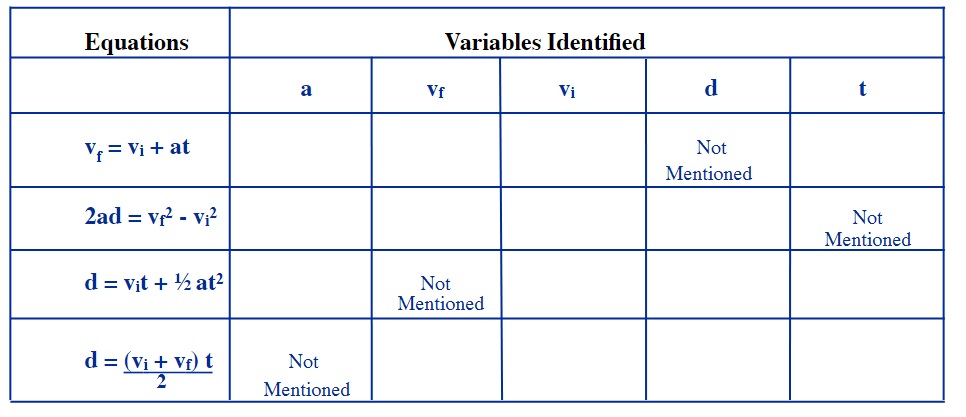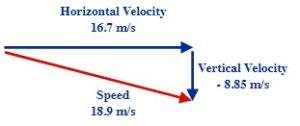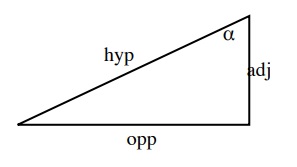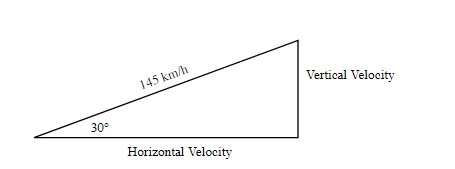Chapter 5: Projectile Motion

Equations Used for this Topic: (All equations are generally written and solved as vector and all variables are the same measures and units as Chapter 3)
All measures are separated into vertical and horizontal components and assume zero air resistance.
Vertical Horizontal Data
a= – 9.80 m/s2 v =
vi = d =
v f= t =
d =
t =
Variables Used …
v is Average Speed, commonly measured in Metres/Second (m/s) or Kilometres/Hour (km/h)
[latex]\overrightarrow{v}[/latex] is Average Velocity, commonly measured in Metres/Second (m/s) or Kilometres/Hour (km/h) and includes a direction
vi is Initial Speed, commonly measured in Metres/Second (m/s) or Kilometres/Hour (km/h
[latex]\overrightarrow{v}_i[/latex] is Initial Velocity, commonly measured in Metres/Second (m/s) or Kilometres/Hour (km/h) and includes a direction
vf is Final Speed, commonly measured in Metres/Second (m/s) or Kilometres/Hour (km/h)
vf is Final Velocity, commonly measured in Metres/Second (m/s) or Kilometres/Hour (km/h) and includes a direction
[latex]\Delta{d}[/latex] is Distance traveled, commonly measured in Metres (m), Kilometres (km)
[latex]\Delta{\overrightarrow{d}}[/latex] is Change in Displacement, commonly measured in Metres (m), Kilometres (km) and includes a direction
a is Acceleration (deceleration is negative), measured in Metres per Second squared (m/s2)
[latex]\overrightarrow{a}[/latex] is Vector Acceleration, measured in Metres per Second squared (m/s2) and includes a direction
t is Time, commonly measured in Seconds (s) or Hours (h)

5.1 Horizontally Launched Projectiles 4, 5
All measures are separated into vertical and horizontal components
Vertical Data Horizontal Data
[latex]\overrightarrow{a} = -9.8 m/s{^2}[/latex] [latex]\overrightarrow{v} =[/latex]
[latex]\overrightarrow{v}_i =[/latex] [latex]\Delta{\overrightarrow{d}}=[/latex]
[latex]\overrightarrow{v}_f =[/latex] t =
[latex]\overrightarrow{d}=[/latex]
t =
The reason for breaking all data into vertical and horizontal components is that gravity acts vertically and as such, only affects the vertical motion. The horizontal motion remains constant until the point that air resistance begins to affect both the vertical and horizontal motion. At this point, the physics that we use in algebra breaks down for the analysis of projectiles.
Historically, the study of projectiles was one of the first to gain importance due to its relevance in warfare, where the range and destructiveness of cannons was one of the projectiles studied. Until early researchers were able to break projectile motion into air resistance affected and non-affected, the narratives used were rather creative. The most common theory prior to accounting for air resistance was from the Theory of Impetus 6.
Impetus Theory, which underpinned the understanding of projectiles, was originated by John Philoponus and Avicenna in 6 AD, and adopted and expanded my Nur ad-Din al-Bitruji at the end of the 12th century. It was adopted into Western scientific thought by Jean Buridan in the 14th century.
“When a mover sets a body in motion he implants into it a certain impetus, that is, a certain force enabling a body to move in the direction in which the mover starts it, be it upwards, downwards, sidewards, or in a circle. The implanted impetus increases in the same ratio as the velocity. It is because of this impetus that a stone moves on after the thrower has ceased moving it. But because of the resistance of the air (and also because of the gravity of the stone) which strives to move it in the opposite direction to the motion caused by the impetus, the latter will weaken all the time. Therefore the motion of the stone will be gradually slower, and finally the impetus is so diminished or destroyed that the gravity of the stone prevails and moves the stone towards its natural place. In my opinion one can accept this explanation because the other explanations prove to be false whereas all phenomena agree with this one.”
Jean Buridan 14th Century
Eventually, the Theory of Impetus was further refined into the concept of inertia by Galileo, and was later quantified by Isaac Newton in his three Laws of Forces (Chapter 6). This Law of Inertia simply states that an object in motion or a state of rest remains in that exact state of motion or rest unless an unbalanced force acts upon it.
In applying this to the analysis of projectiles:
Vertical Motion is constantly affected by the Earth’s gravity, resulting in the vertical motion constantly accelerating at 9.80 m/s2 downward near the Earth’s surface.
Horizontal Motion remains constant since the Earth’s gravity only affects any motion up or down, not horizontal.
This means that in analyzing projectile motion, the motion must be broken up into vertical and horizontal components. The vertical part of the projectile’s motion will be constantly accelerated by gravity (solved by the four kinematic equations) and the horizontal part will remain at a constant horizontal velocity (solved by the constant velocity equation).
Four Kinematic Equations Constant Velocity Equation
[latex]\overrightarrow{d} =\dfrac{\overrightarrow{v}_i +\overrightarrow{v}_f)t}{2}[/latex] [latex]\overrightarrow{v}_f =\overrightarrow{v}_i +\overrightarrow{a}t[/latex] [latex]\overrightarrow{v} =\dfrac{\Delta{\overrightarrow{d}}}{t}[/latex]
[latex]2\overrightarrow{a}\overrightarrow{d} =\overrightarrow{v}_f{^2} -\overrightarrow{v}_i{^2}[/latex] [latex]\overrightarrow{d} = \overrightarrow{v}_it = ½\overrightarrow{a}t{^2}[/latex]
The choice of equation to use can still be solved by using the chart introduced in Chapter 3.
EXAMPLE 5.1.1
In a movie, a stunt driver is to drive a car over a 4.0 m vertical drop traveling at 60 km/h. (i) At what velocity (vertical and horizontal) does this car strike the ground?7 [footnote?] (ii) What speed would this be?
Data
| VERTICAL DATA | HORIZONTAL DATA | |
| [latex]\overrightarrow{a} = - 9.8 m/s{^2}[/latex] | [latex]\overrightarrow{v}=\text{ 60 km/h or 16.7 m/s} (\approx 17 m/s)[/latex] | |
| [latex]\overrightarrow{v}_i = 0 m/s[/latex] | [latex]\text{Horizontal velocity remains constant}[/latex] | |
| [latex]\overrightarrow{v}_f = find[/latex] | [latex]2\overrightarrow{a}\overrightarrow{d} = \overrightarrow{v}_f{^2} -\overrightarrow{v}_i\overrightarrow{^2}[/latex] | |
| [latex]\overrightarrow{d} = - 4.0 m[/latex] | [latex]2 (\text{-9.80 m/s}{^2})(- 4.0 m) =\overrightarrow{v}_f{^2} - 0 m/s[/latex] | |
| [latex]t = No[/latex] | [latex]78.4 m{^2}/s{^2} = \overrightarrow{v}_f{^2}[/latex] | |
| [latex]78.4 m{^2}/s{^2} = \overrightarrow{v}_f{^2}[/latex] | ||
| [latex]\overrightarrow{v}_f{^2} = 78.4 m{^2}/s{^2}[/latex] | ||
| [latex]{v}_f = \underline{+} 8.85 m/s[/latex] | ||
| Choose [latex]\overrightarrow{v}_f =\text{ -8.85 m/s} (\approx -8.9 m/s)[/latex] |
Data
To solve for the speed one must find the hypotenuse of these two velocity vectors. This is most easily done by using the Pythagorean Theorem: a2 + b2 = c2
Therefore the speed is:
v2 = (- 8.85 m/s)2 + (16.7 m/s)

v2 = 78.4 m2/s2 + 277.8 m2/s2
v2 = 356.2 m2/s2
v = 18.9 m/s (≈ 19 m/s)
EXAMPLE 5.1.2
A marble rolls off a 1.5 m high bench with a velocity of 0.80 m/s. What horizontal distance does it travel before it strikes the floor?
Data
| VERTICAL DATA | HORIZONTAL DATA |
| [latex]\overrightarrow{a} = -9.80 m/s{^2}[/latex] | [latex]\overrightarrow{v} = 0.80 m/s[/latex] |
| [latex]\overrightarrow{v}_i = 0 m/s[/latex] | [latex]\Delta{\overrightarrow{d}} = find[/latex] |
| [latex]\overrightarrow{v}_f = No[/latex] | |
| [latex]\overrightarrow{d} = 1.5 m[/latex] | [latex]t =\text{ Use from Vertical}[/latex] |
| [latex]t =\text{find 1st}[/latex] |
First, find the time in the air.
[latex]\overrightarrow{d} =\overrightarrow{v}_{i}t + ½ (- 9.80 m/s^{2})(t)^{2}[/latex]
– 1.5 m = (0 m/s)(t) + ½ (- 9.80 m/s2)(t)2
– 1.5 m = (- 4.9 m/s2)(t)2
(t)2 = – 1.5 m ÷ – 4.9 m/s2
t2 = 0.306 s2t = 0.55 s
Second, find the horizontal distance the marble travels.
[latex]\overrightarrow{v} =\dfrac{\Delta{\overrightarrow{d}}}{t}[/latex]
[latex]0.8 m/s =\dfrac{\Delta{d}}{0.55 s}[/latex]
[latex]\Delta{d}[/latex]= (0.8 m/s)(0.55 s)
[latex]\Delta{d}[/latex]= 0.44 m
EXAMPLE 5.1.3
A rock is thrown horizontally from a cliff with a velocity of 20 m/s. What is the vertical and horizontal displacement8 of this rock after 3.0 s?
| VERTICAL DATA | HORIZONTAL DATA |
| [latex]\overrightarrow{a} =\text{ - 9.80 m/s}{^2}[/latex] | [latex]\overrightarrow{v} =\text{ 20 m/s}[/latex] |
| [latex]\overrightarrow{v}_i =\text{ 0 m/s}[/latex] | |
| [latex]v_{f} = No[/latex] | [latex]\Delta\overrightarrow{d} = find[/latex] |
| [latex]\overrightarrow{d} = find[/latex] | [latex]t =\text{3.0 s}[/latex] |
| [latex]t =\text{3.0 s}[/latex] |
First, find the vertical displacement.
[latex]\overrightarrow{d} =\overrightarrow{v}_it +\dfrac{\overrightarrow{1}}{2}at{^2}[/latex]
[latex]\overrightarrow{d} = (0 m/s)(t) + ½ (-9.80 m/s{^2})(3.0){^2}[/latex]
[latex]\overrightarrow{d} = (-4.9 m/s{^2})(9.0 s{^2})[/latex]
[latex]\overrightarrow{d} = - 44.1 m (-44 m)[/latex]
Second, find the horizontal displacement.
[latex]\overrightarrow{v} =\dfrac{\Delta{\overrightarrow{d}}}{t}[/latex]
[latex]\Delta\overrightarrow{d} = (20 m/s)(3.0 s)[/latex]
[latex]\Delta\overrightarrow{d} = 60 m[/latex]
Therefore, the total displacement change of the rock in those 3.0 s is:
[latex]\Delta\overrightarrow{d}[/latex] = – 44 m vertical and 60 m horizontal
The distance traveled would be found by using the Pythagorean Theorem from this data.
QUESTIONS 5.1 Horizontally Launched Projectiles
1. A rock is thrown horizontally from a bridge. By the time it strikes the water 44.1 m below, the rock has traveled a horizontal displacement of 15.0 m. With what horizontal velocity was this rock thrown?
2. A sea rescue airplane flying at 120 km/h and 45 m above water discovers shipwrecked people floating in a group. At what amount of time before they fly over the people should the aircraft drop emergency supplies?
3. A diver running 3.5 m/s dives from the edge of a vertical cliff and reaches the water below 1.5 s later. How high was the cliff and how far from its base did this diver hit the water?

4. A water balloon is thrown out of a window (10.0 m above ground) with a horizontal velocity of 6.0 m/s. Will the balloon hit a sunbather tanning on the ground that is 12 m away from the base of the window?
5. A sack of flour is dropped from an airplane traveling at 125 m/s horizontally when 490 m above ground. How far forwards from the spot over which it dropped does the sack land? (Ignore air resistance.)
6. A car drives over a 20 m vertical drop traveling at 75 km/h. At what velocity (vertical and horizontal) does this car strike the ground?
7. A UN airplane on a rescue mission into hostile territory has a horizontal velocity of 500 km/h and drops a supply package at an altitude of 1500 m. If the chute fails to open and air resistance does not affect the motion, (i) in what amount of time would this package impact the ground? (ii) What horizontal distance would this package have traveled? (iii) What would be the package’s impact speed? (Ignore air resistance.)
8. A stone is thrown horizontally from a cliff with a velocity of 12 m/s. (i) What is the stone’s vertical displacement after 1.0 s? (ii) What is the stone’s vertical displacement after 2.0 s?
9. A cannon fires a cannonball with a velocity of 200 m/s with its barrel horizontal at a height of 1.2 m above the ground. (i) How long would the cannon ball remain airborne before impacting the ground? (ii) What is the vertical and horizontal displacement of the cannonball when it strikes the ground? (iii) Which answers above change if the launch velocity was reduced to 150 m/s?
10. A pea is rolled off a table 1.0 m high with a velocity of 1.2 m/s. With what speed does this pea strike the floor?
11. Back in the early 1970s a bush pilot started to bomb a small town in Northern Alberta with 5 pound bags of flour. He dropped about a dozen bags and managed to flatten one outhouse, dusting a couple of cars but no people. He was arrested upon landing. If he was flying at 120 km/h (horizontally) at a height of 50 m, what horizontal distance in front of his intended target should he have dropped his “bomb”?
5.2 Projectiles Launched at an Angle

All measures are broken up into vertical and horizontal components, generally using right angled trigonometry where
Basic Trigonometric Ratios
Sin = Opposite Cos = Adjacent Tan = Opposite
Hypotenuse Hypotenuse Adjacent
Trigonometric Defined Sides


As before, the choice of equation to use can be solved by using the chart introduced in Chapter 3.

EXAMPLE 5.2.1
Suppose a baseball is hit and leaves the bat at 145 km/h at an angle of 30° above the horizontal. In the absence of air resistance, what horizontal displacement would it travel before falling back to the height that it was struck?
First, you need to find the baseball’s vertical and horizontal components at launch.
The velocity broken into components:

Vertical
Data:
ø = 30°
Launch Velocity = 145 km/h or 40.3 m/s
Vertical Velocity = find
Trigonometry Relationship to use is the Sine Function:
Sin 30° = Vertical Velocity / 40.3 m/s
Vertical Velocity = (40.3 m/s)(Sin 30°)
Vertical Velocity = 20.2 m/s
Horizontal
Data:
ø = 30°
Launch Velocity = 145 km/h or 40.3 m/s
Horizontal Velocity = find
Trigonometry Relationship to use is the Cosine Function:
Cos 30° = Horizontal Velocity / 40.3 m/s
Horizontal Velocity = (40.3 m/s)(Cos 30°)
Horizontal Velocity = 34.9 m/s
This data is now put into the following chart:
| VERTICAL DATA | HORIZONTAL DATA |
| [latex]\overrightarrow{a} = - 9.80 m/s^{2}[/latex] | [latex]\overrightarrow{v} = 34.9 m/s[/latex] |
| [latex]\overrightarrow{v}_{i} = 20.2 m/s[/latex] | [latex]\Delta{\overrightarrow{d}} = find[/latex] |
| [latex]\overrightarrow{d} = No[/latex] | [latex]t =\text{Use Vertical}[/latex] |
| [latex]t =\text{find 1st}[/latex] |
First we use symmetry to sort out the data. If the baseball is launched at 20.2 m/s vertical, then it should return to the same height at 20.2 m/s in the opposite direction, as long as air resistance can be ignored.
Using the vertical data, the equation to be used is:
[latex]\overrightarrow{v}_f = \overrightarrow{v}_i +\overrightarrow{a}t[/latex]
Therefore: – 20.2 m/s = 20.2 m/s + (-9.80 m/s2) t
(-9.80 m/s2) t = – 20.2 m/s – 20.2 m/s
Leaving: t = – 40.4 m/s / – 9.80 m/s2 or 4.12 s
We now use this 4.12 s to find out how far the baseball traveled before it returned to the height it was struck at.
Using the horizontal data, the equation to be used is:
[latex]\overrightarrow{v} =\dfrac{\overrightarrow{d}}{t}[/latex]
Therefore: 34.9 m/s = horizontal displacement / 4.12 s
Leaving: the horizontal displacement = (34.9 m/s)(4.12 s) or 144 m
In reality this 144 m will be affected by air resistance and other factors.
QUESTIONS 5.2 Projectiles Launched at an Angle (these take more time to solve).
1. A cannonball is launched at 120 m/s at an angle of 35° above the horizontal.

(i) What are the initial vertical and horizontal launch velocities?
(ii) What is the maximum vertical displacement reached?
(iii) What amount of time will it take the cannonball to return to its launch height?
(iv) What horizontal displacement will it have traveled when it has returned to its launch height?
2. Captain Ed, in training new recruits, is directing a fire hose at an angle of 15° above the horizontal from the roof of one building to a different building 42 m away. If the water is leaving the hose at 35 m/s, where will the water be striking the other building?
REFERENCES:
1. This image is taken from a book on artillery by Diego Ufano (1628) that attempted to adapt the knowledge of artillerists in the attempt of understanding projectile trajectories
2. A-Level Physics Tutor: http://www.a-levelphysicstutor.com/index-mech.php
3. Extra Help – What is a Projectile: https://www.physicsclassroom.com/class/vectors/Lesson-2/What-is-a-Projectile
4. Extra Help – Characteristics of a Projectile’s Trajectory: https://www.physicsclassroom.com/class/vectors/Lesson-2/Characteristics-of-a-Projectile-s-Trajectory
5. Extra Help – Horizontally Launched Projectile Problems: https://www.physicsclassroom.com/class/vectors/Lesson-2/Horizontally-Launched-Projectiles-Problem-Solving
6. Theory of Impetus: https://en.wikipedia.org/wiki/Theory_of_impetus

